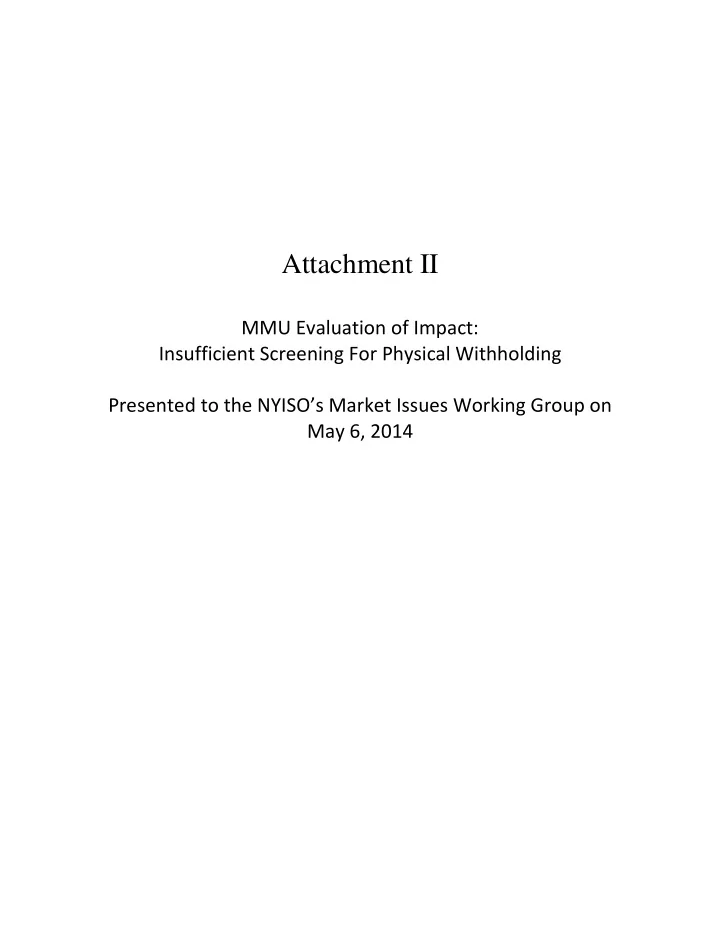

Attachment II MMU Evaluation of Impact: Insufficient Screening For Physical Withholding Presented to the NYISO’s Market Issues Working Group on May 6, 2014
MMU Evaluation of Impact: Insufficient Screening for Physical Withholding Pallas LeeVanSchaick Potomac Economics Market Monitoring Unit Market Issues Working Group May 6, 2014
Introduction • On April 8, 2013, the NYISO determined that the screen used to check for potential physical withholding conduct does not apply the portfolio criteria appropriately. The issue was identified following an ad hoc review of the report by MMA staff. • The MMU was asked to evaluate the effects of the issue and report our findings to stakeholders. On May 3, 2013, the MMU provided a preliminary evaluation of the market effects of the issue for the last month before the issue was identified (March 2013). • This presentation describes the issue and provides our final evaluation of the market effects for the last 12 months before the issue was identified (April 2012 to March 2013). - 2 -
Description of the Incorrect Screening Criteria • MST Section 23.3.1.1.1.1 requires the NYISO to screen for potential physical withholding where the unoffered amount exceeds: 100 MW or 10 percent of capability of a Generator; or 200 MW or 5 percent of capability in a portfolio. In NYC, the MW-thresholds are 50 MW and 100 MW, respectively. • The generator-specific screens were performed correctly. However, portfolio-level unoffered capacity was incorrect – based on average unoffered MWs per unit in the portfolio rather than total MWs in the portfolio; and Generator-level MWs exceeding 10 percent were frequently deemed unlikely to be significant based on the portfolio-level criteria. • Consequently, potentially withheld MWs were not evaluated for some Generators with under 100 MW (50 MW in NYC) of such capacity. This is most relevant for portfolios with a large amount of peaking capacity. - 3 -
Potential Impacts in the DAM and RTM • The effect of the issue was very limited in the DAM because unscreened units were generally identified by one of the following: The NYISO’s ICAP compliance process, which confirms suppliers offer in the DAM or log outage appropriately. The NYISO’s review of generator outage logs for consistency with outage scheduling rules and procedures and audits of selected generators. The NYISO’s generator -specific screens. • The effect of the issue was limited in the RTM by several other processes that helped screen for physical withholding: The NYISO’s generator -specific screens; The NYISO’s insufficient portfolio screens; and The MMU’s monitoring of unutilized economic capacity. - 4 -
Detailed Evaluation of Impact in the RTM • To determine whether the insufficient physical withholding screen had a significant market impact, the NYISO re-screened the 12 months from April 2012 to March 2013 using corrected software. • Before performing a detailed review of the screened conduct, the NYISO excluded conduct that was very unlikely to constitute physical withholding that would meet the tariff-defined price impact thresholds. The NYISO excluded: Conduct that the insufficient portfolio screen successfully identified. ROS conduct that occurred during hours that do not meet certain pre- impact criteria (e.g., at least one zone LBMP > $150). NYC conduct that occurred during hours that did not meet ROS pre- impact criteria or load pocket impact criteria. • The remaining 746 GWh of potential physical withholding conduct was subject to a more detailed review. - 5 -
Detailed Evaluation of Impact in the RTM • The more detailed assessment that was performed to review the remaining 746 GWh determined. 29 percent were likely attributable to ambient temperature deratings and units offering at their UOLn rather than UOLe. 27 percent were on units that were ultimately found to have logged a maintenance outage by email rather than using the automated system. 21 percent were on energy limited and/or intermittent resources. 11 percent were on peaking units that provided a competitive justification that was deemed legitimate by the NYISO. 4 percent were on units under PURPA contracts. • For the remaining 69 GWh, the NYISO determined (and the MMU concurs) that the conduct had a competitive justification or that the conduct did not have sufficient market impact to warrant a financial sanction. - 6 -
Conclusions • The issues with the screening software did not cause the NYISO to fail to sanction physical withholding conduct that would have been sanctioned if the portfolio screen had been implemented correctly. This is partly because: The NYISO’s rigorous ICAP compliance process leads to very low levels of unoffered capacity in the DAM. There is relatively little unoffered capacity in the RTM. Much of the potential physical withholding is not actually available due to ambient temperatures, maintenance logging issues, and energy limitations. The LBMP-impact thresholds are large in ROS, and congestion is relatively infrequent in NYC. • The NYISO continues to refine the process for evaluating potential physical withholding and the criteria for evaluating competitive justifications. • Based on the results of this analysis, the NYISO will request a waiver from FERC of its obligation to review periods prior to April 2012. - 7 -
Recommend
More recommend